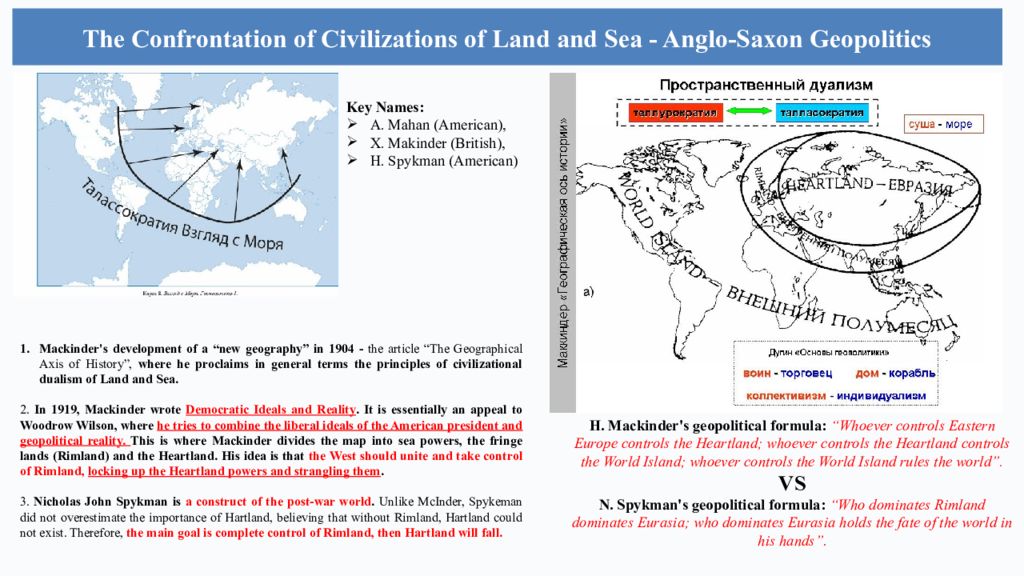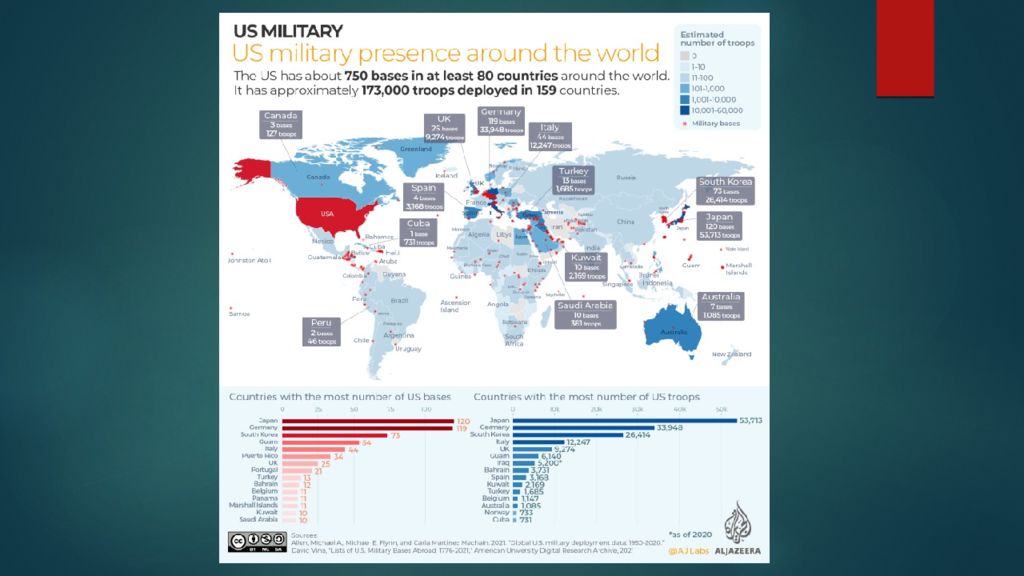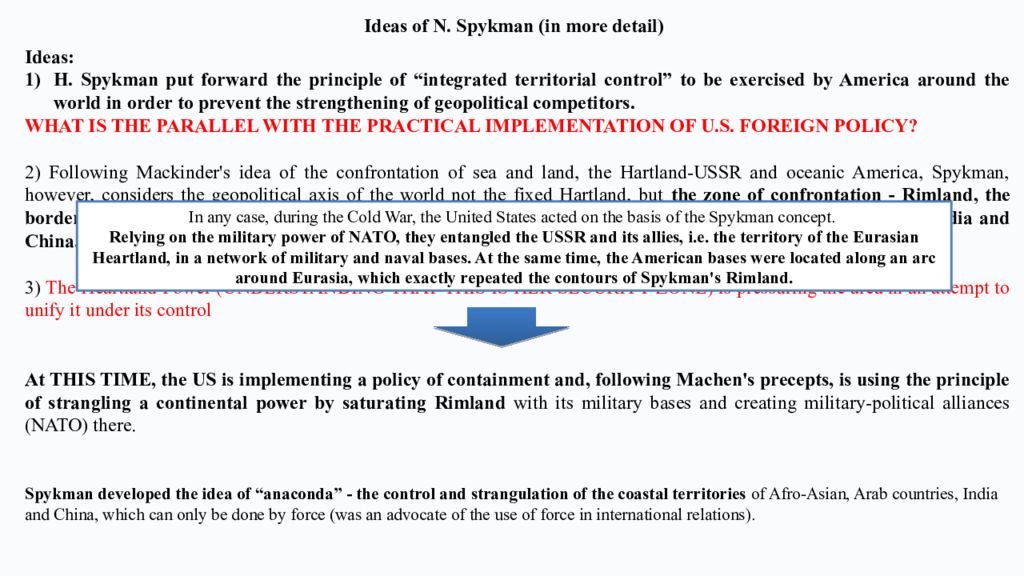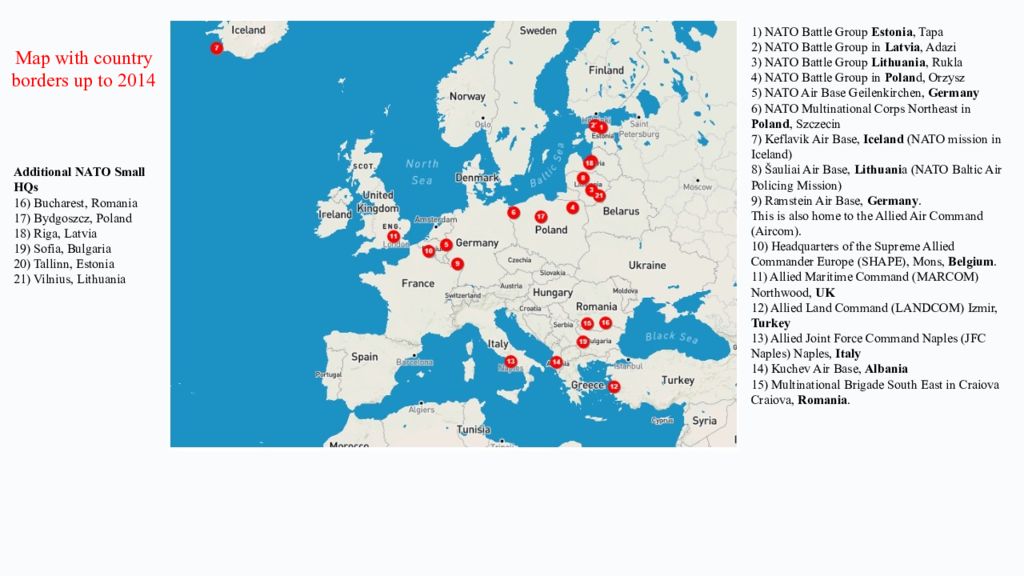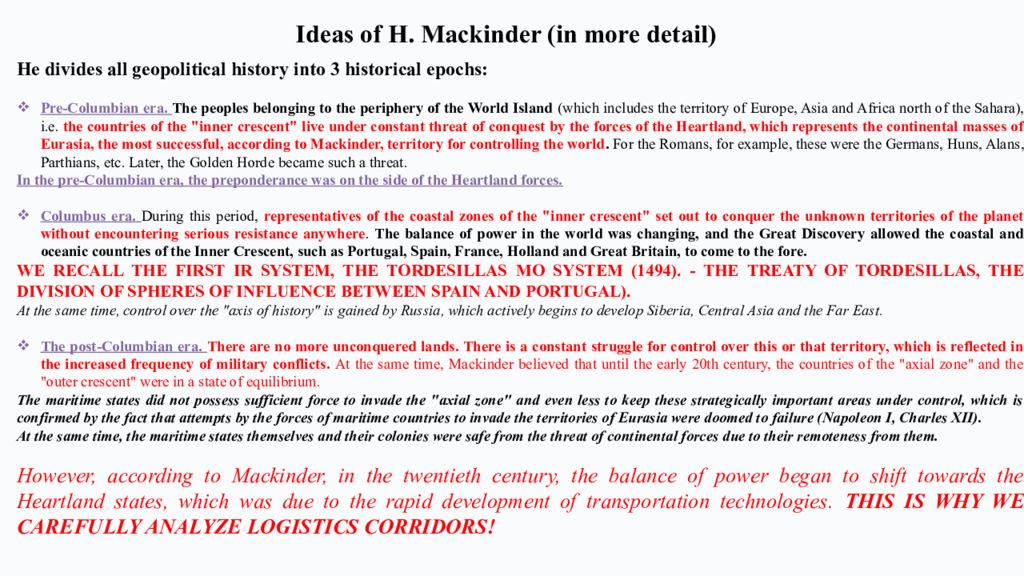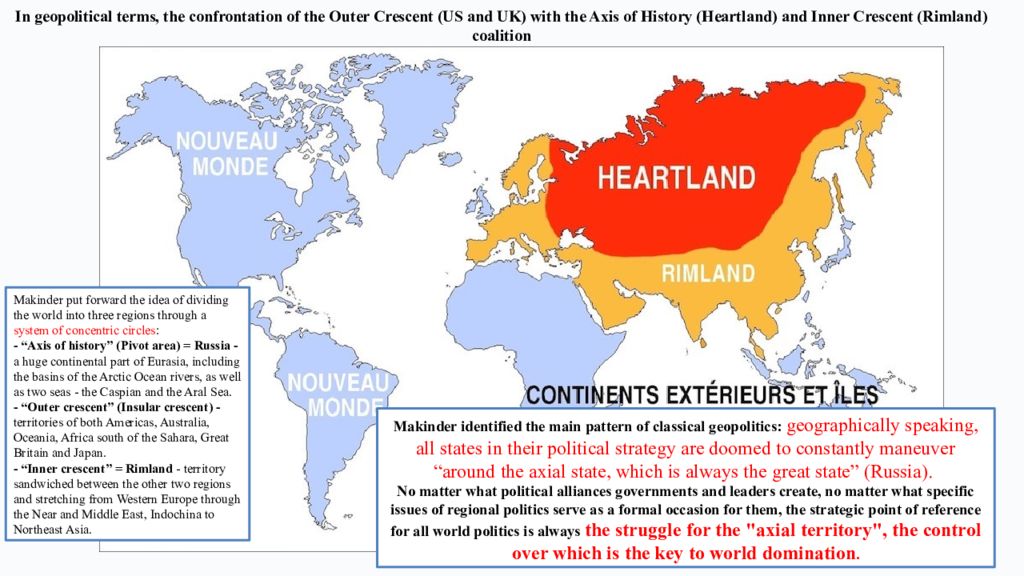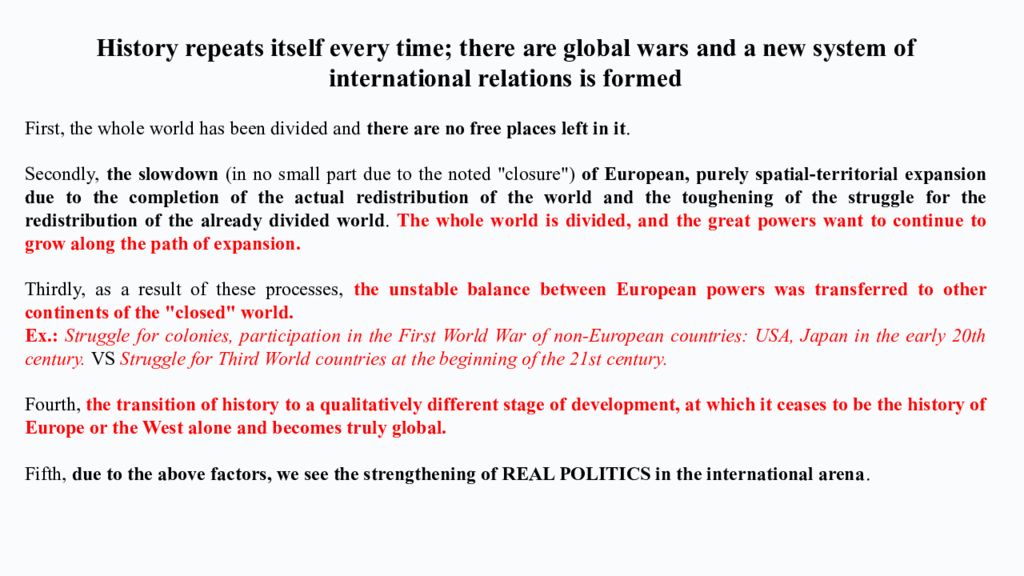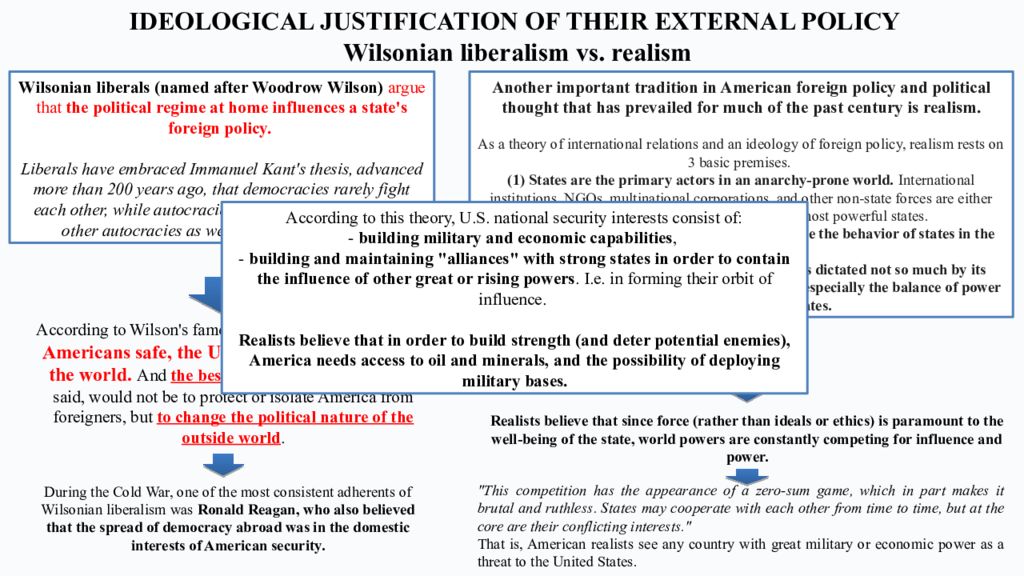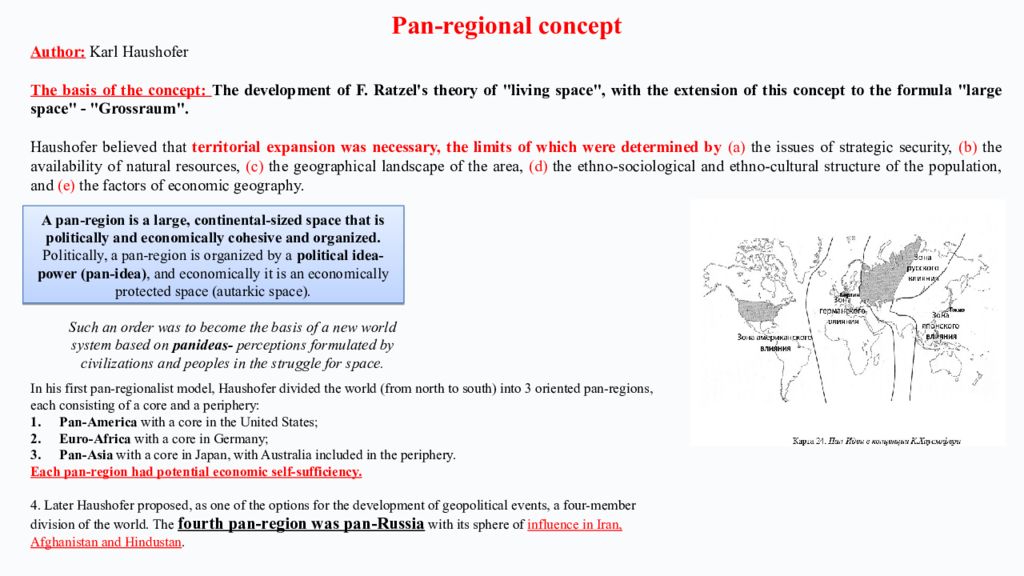Первый слайд презентации: The Confrontation of Civilizations of Land and Sea - Anglo-Saxon Geopolitics
Key Names: А. Mahan (American), Х. Makinder (British), Н. Spykman (American) Mackinder's development of a “new geography” in 1904 - the article “The Geographical Axis of History”, where he proclaims in general terms the principles of civilizational dualism of Land and Sea. 2. In 1919, Mackinder wrote Democratic Ideals and Reality. It is essentially an appeal to Woodrow Wilson, where he tries to combine the liberal ideals of the American president and geopolitical reality. This is where Mackinder divides the map into sea powers, the fringe lands ( Rimland ) and the Heartland. His idea is that the West should unite and take control of Rimland, locking up the Heartland powers and strangling them. 3. Nicholas John Spykman is a construct of the post-war world. Unlike McInder, Spykeman did not overestimate the importance of Hartland, believing that without Rimland, Hartland could not exist. Therefore, the main goal is complete control of Rimland, then Hartland will fall. H. Mackinder's geopolitical formula: “Whoever controls Eastern Europe controls the Heartland; whoever controls the Heartland controls the World Island; whoever controls the World Island rules the world”. VS N. Spykman's geopolitical formula: “Who dominates Rimland dominates Eurasia; who dominates Eurasia holds the fate of the world in his hands”.
Слайд 3: Ideas of N. Spykman (in more detail)
Ideas: Н. Spykman put forward the principle of “integrated territorial control” to be exercised by America around the world in order to prevent the strengthening of geopolitical competitors. WHAT IS THE PARALLEL WITH THE PRACTICAL IMPLEMENTATION OF U.S. FOREIGN POLICY? 2) Following Mackinder's idea of the confrontation of sea and land, the Hartland-USSR and oceanic America, Spykman, however, considers the geopolitical axis of the world not the fixed Hartland, but the zone of confrontation - Rimland, the border zone of land and sea, stretching along the borders of the Hartland through Europe, the Middle East, India and China. 3) The Heartland Power (UNDERSTANDING THAT THIS IS HER SECURITY ZONE) is pressuring the area in an attempt to unify it under its control At THIS TIME, the US is implementing a policy of containment and, following Machen's precepts, is using the principle of strangling a continental power by saturating Rimland with its military bases and creating military-political alliances (NATO) there. Spykman developed the idea of “anaconda” - the control and strangulation of the coastal territories of Afro-Asian, Arab countries, India and China, which can only be done by force (was an advocate of the use of force in international relations). In any case, during the Cold War, the United States acted on the basis of the Spykman concept. Relying on the military power of NATO, they entangled the USSR and its allies, i.e. the territory of the Eurasian Heartland, in a network of military and naval bases. At the same time, the American bases were located along an arc around Eurasia, which exactly repeated the contours of Spykman's Rimland.
Слайд 4
Map with country borders up to 2014 1) NATO Battle Group Estonia, Tapa 2) NATO Battle Group in Latvia, Adazi 3) NATO Battle Group Lithuania, Rukla 4) NATO Battle Group in Polan d, Orzysz 5) NATO Air Base Geilenkirchen, Germany 6) NATO Multinational Corps Northeast in Poland, Szczecin 7) Keflavik Air Base, Iceland (NATO mission in Iceland) 8) Šauliai Air Base, Lithuani a (NATO Baltic Air Policing Mission) 9) Ramstein Air Base, Germany. This is also home to the Allied Air Command ( Aircom ). 10) Headquarters of the Supreme Allied Commander Europe (SHAPE), Mons, Belgium. 11) Allied Maritime Command (MARCOM) Northwood, UK 12) Allied Land Command (LANDCOM) Izmir, Turkey 13) Allied Joint Force Command Naples (JFC Naples) Naples, Italy 14) Kuchev Air Base, Albania 15) Multinational Brigade South East in Craiova Craiova, Romania. Additional NATO Small HQs 16) Bucharest, Romania 17) Bydgoszcz, Poland 18) Riga, Latvia 19) Sofia, Bulgaria 20) Tallinn, Estonia 21) Vilnius, Lithuania
Слайд 5: Ideas of H. Mackinder (in more detail)
He divides all geopolitical history into 3 historical epochs: Pre-Columbian era. The peoples belonging to the periphery of the World Island (which includes the territory of Europe, Asia and Africa north of the Sahara), i.e. the countries of the "inner crescent" live under constant threat of conquest by the forces of the Heartland, which represents the continental masses of Eurasia, the most successful, according to Mackinder, territory for controlling the world. For the Romans, for example, these were the Germans, Huns, Alans, Parthians, etc. Later, the Golden Horde became such a threat. In the pre-Columbian era, the preponderance was on the side of the Heartland forces. Columbus era. During this period, representatives of the coastal zones of the "inner crescent" set out to conquer the unknown territories of the planet without encountering serious resistance anywhere. The balance of power in the world was changing, and the Great Discovery allowed the coastal and oceanic countries of the Inner Crescent, such as Portugal, Spain, France, Holland and Great Britain, to come to the fore. WE RECALL THE FIRST IR SYSTEM, THE TORDESILLAS MO SYSTEM (1494). - THE TREATY OF TORDESILLAS, THE DIVISION OF SPHERES OF INFLUENCE BETWEEN SPAIN AND PORTUGAL). At the same time, control over the "axis of history" is gained by Russia, which actively begins to develop Siberia, Central Asia and the Far East. The post-Columbian era. There are no more unconquered lands. There is a constant struggle for control over this or that territory, which is reflected in the increased frequency of military conflicts. At the same time, Mackinder believed that until the early 20th century, the countries of the "axial zone" and the "outer crescent" were in a state of equilibrium. The maritime states did not possess sufficient force to invade the "axial zone" and even less to keep these strategically important areas under control, which is confirmed by the fact that attempts by the forces of maritime countries to invade the territories of Eurasia were doomed to failure (Napoleon I, Charles XII). At the same time, the maritime states themselves and their colonies were safe from the threat of continental forces due to their remoteness from them. However, according to Mackinder, in the twentieth century, the balance of power began to shift towards the Heartland states, which was due to the rapid development of transportation technologies. THIS IS WHY WE CAREFULLY ANALYZE LOGISTICS CORRIDORS!
Слайд 6
Makinder put forward the idea of dividing the world into three regions through a system of concentric circles : - “Axis of history” (Pivot area) = Russia - a huge continental part of Eurasia, including the basins of the Arctic Ocean rivers, as well as two seas - the Caspian and the Aral Sea. - “Outer crescent” (Insular crescent) - territories of both Americas, Australia, Oceania, Africa south of the Sahara, Great Britain and Japan. - “Inner crescent” = Rimland - territory sandwiched between the other two regions and stretching from Western Europe through the Near and Middle East, Indochina to Northeast Asia. Makinder identified the main pattern of classical geopolitics: geographically speaking, all states in their political strategy are doomed to constantly maneuver “around the axial state, which is always the great state” (Russia). No matter what political alliances governments and leaders create, no matter what specific issues of regional politics serve as a formal occasion for them, the strategic point of reference for all world politics is always the struggle for the "axial territory", the control over which is the key to world domination. In geopolitical terms, the confrontation of the Outer Crescent (US and UK) with the Axis of History (Heartland) and Inner Crescent ( Rimland ) coalition
Слайд 7
History repeats itself every time ; there are global wars and a new system of international relations is formed First, the whole world has been divided and there are no free places left in it. Secondly, the slowdown (in no small part due to the noted "closure") of European, purely spatial-territorial expansion due to the completion of the actual redistribution of the world and the toughening of the struggle for the redistribution of the already divided world. The whole world is divided, and the great powers want to continue to grow along the path of expansion. Thirdly, as a result of these processes, the unstable balance between European powers was transferred to other continents of the "closed" world. Ex.: Struggle for colonies, participation in the First World War of non-European countries: USA, Japan in the early 20th century. VS Struggle for Third World countries at the beginning of the 21st century. Fourth, the transition of history to a qualitatively different stage of development, at which it ceases to be the history of Europe or the West alone and becomes truly global. Fifth, due to the above factors, we see the strengthening of REAL POLITICS in the international arena.
Слайд 8: IDEOLOGICAL JUSTIFICATION OF THEIR EXTERNAL POLICY Wilsonian liberalism vs. realism
Wilsonian liberals (named after Woodrow Wilson) argue that the political regime at home influences a state's foreign policy. Liberals have embraced Immanuel Kant's thesis, advanced more than 200 years ago, that democracies rarely fight each other, while autocracies are prone to conflict with other autocracies as well as with democracies. According to Wilson's famous phrase, in order to keep Americans safe, the United States must change the world. And the best way to ensure security, he said, would not be to protect or isolate America from foreigners, but to change the political nature of the outside world. During the Cold War, one of the most consistent adherents of Wilsonian liberalism was Ronald Reagan, who also believed that the spread of democracy abroad was in the domestic interests of American security. Another important tradition in American foreign policy and political thought that has prevailed for much of the past century is realism. As a theory of international relations and an ideology of foreign policy, realism rests on 3 basic premises. (1) States are the primary actors in an anarchy-prone world. International institutions, NGOs, multinational corporations, and other non-state forces are either unimportant or reflect the interests of the most powerful states. (2) The domestic political regime does not influence the behavior of states in the external world. (3) A state's behavior in the international arena is dictated not so much by its internal structure as by the external environment, especially the balance of power between the strongest states. Realists believe that since force (rather than ideals or ethics) is paramount to the well-being of the state, world powers are constantly competing for influence and power. "This competition has the appearance of a zero-sum game, which in part makes it brutal and ruthless. States may cooperate with each other from time to time, but at the core are their conflicting interests." That is, American realists see any country with great military or economic power as a threat to the United States. According to this theory, U.S. national security interests consist of: - building military and economic capabilities, - building and maintaining "alliances" with strong states in order to contain the influence of other great or rising powers. I.e. in forming their orbit of influence. Realists believe that in order to build strength (and deter potential enemies), America needs access to oil and minerals, and the possibility of deploying military bases.
Слайд 9: Pan-regional concept
Author: Karl Haushofer The basis of the concept : The development of F. Ratzel's theory of "living space", with the extension of this concept to the formula "large space" - " Grossraum ". Haushofer believed that territorial expansion was necessary, the limits of which were determined by ( a) the issues of strategic security, (b) the availability of natural resources, (c) the geographical landscape of the area, (d) the ethno-sociological and ethno-cultural structure of the population, and (e) the factors of economic geography. A pan-region is a large, continental-sized space that is politically and economically cohesive and organized. Politically, a pan-region is organized by a political idea-power (pan-idea), and economically it is an economically protected space (autarkic space). Such an order was to become the basis of a new world system based on panideas - perceptions formulated by civilizations and peoples in the struggle for space. In his first pan-regionalist model, Haushofer divided the world (from north to south) into 3 oriented pan-regions, each consisting of a core and a periphery: Pan-America with a core in the United States; Euro-Africa with a core in Germany; Pan-Asia with a core in Japan, with Australia included in the periphery. Each pan-region had potential economic self-sufficiency. 4. Later Haushofer proposed, as one of the options for the development of geopolitical events, a four-member division of the world. The fourth pan-region was pan-Russia with its sphere of influence in Iran, Afghanistan and Hindustan.
